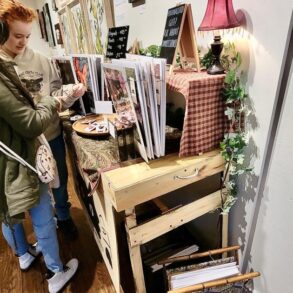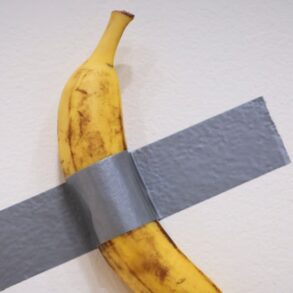Art Market
Osman Can Yerebakan
Sep 23, 2024 12:00PM
Interior view of Thaddaeus Ropac, London. Photo by Aggie Cherrie. Courtesy of Thaddaeus Ropac.
In a cultural landscape where a shade of neon green can define the energy of a summer—and even leak into a presidential election—a nuanced visual identity is essential for any brand. And in an art world that is both flashy and mysterious, striking the right visual chord is a subtle and delicate act.
Mega-gallerist Thaddaeus Ropac explains the effort as “finding a balance between people being able to identify us easily and the associations that accompany this recognition, while having the flexibility to adapt according to each location.”
Every gallery starts with an idea, a vision that first starts in the founder’s imagination. The challenge for any budding gallerist is to translate this ambition into a space that continually operates deliberate programming that preserves a perpetually relevant and sharp brand identity. From blue-chip to emerging, each gallery braves the obstacles through its own fiscal and imaginative limitations, as well as the founder’s distinctive taste palette.
Finding the right location
Interior view of James Fuentes, Los Angeles. Courtesy of James Fuente
Advertisement
When James Fuentes opened his storefront on Delancey Street on New York’s Lower East Side in 2010, he intended to pay homage to the big players in Chelsea when the neighborhood was in its heyday. He chose a forest green shade for his façade to salute two influential 24th Street galleries, Luhring Augustine and Andrea Rosen Gallery. For the gallery sign, Fuentes picked a font similar to recently closed longtime Chelsea stalwart Cheim & Read’s sleek aesthetic. “We went with a mash-up of different identities to reflect the space,” Fuentes recalled.
The gallerist, who now has locations in Tribeca and Los Angeles, made sure to leave his own mark: “We wrapped the façade with laser-cut wood brick pattern which was unique—we wanted a look different than all the glass windows around the neighborhood,” he said.
When galleries expand their physical footprint, owners are prompted with the question of growing their brand in a way that feels true to both the location and themselves. For Ropac, whose eponymous gallery has spaces in London, Paris, Salzburg, and Seoul, each space is thought of as a platform to blend the gallery’s elegantly subdued European energy with the local palette. “We choose to make the most of the characteristics of each space rather than having homogenous white cube environments,” said the veteran dealer. The gallery’s London location, for example, occupies Ely House in Mayfair, a storied townhouse that was built in 1776 by Sir Robert Taylor.
Portrait of Thaddaeus Ropac by Romain Duquesne. Courtesy of Thaddaeus Ropac.
Exterior view of Thaddaeus Ropac, London. Photo by James French. Courtesy of Thaddaeus Ropac.
Branding beyond the gallery walls
As well as refining the physical aspects of their spaces, galleries must also consider other forms of outreach to engage their local communities in a way that feels true to their founding mission.
When Sarah Gavlak opened a West Palm Beach location of her Los Angeles–born gallery in 2005, she was aware of the town’s tightly knit affluent and conservative Floridian base—not an immediate alignment with her gallery’s women- and queer-focused artist roster.
“I had to be supportive of my artists and explain them to the local audience,” she said. The dealer responded with a casual art weekend a week prior to (or concurrently with) the neighboring town’s Art Basel Miami Beach in 2017. This included the unveiling of The Bunker Artspace, run by curator and collector Beth DeWoody, which staged events such as a conversation between Jenny Holzer and the writer Eric Shriner, which attracted the audience.
New Art Wknd 2023. Courtesy of Gavlak.
The next year, Gavlak rebranded the weekend venture to New Wave Art Wknd (named after her favorite music genre) with a neon pink website. The modest but tight programming with major key players has helped the annual event evolve into a breezy tradition to cap off the heavily packed neighboring Art Basel Miami Beach marathon. “This is a small nonprofit which I need to keep separate from my gallery,” Gavlak added. The main goal of New Wave is to bring local the community together with the industry figures who are in town for the art fairs.
“I want others to experience what I see and experience around this town,” the dealer said, adding that she also aims to “introduce the local collector base the artists that my gallery fosters.” By focusing the weekend’s programming on women, queer, and immigrant artists, she also carves room for artist groups who “may not be supported in the region and even be under attack,” she said.
Gavlak makes sure to weave subtle connections to the gallery shows with a talk, dinner, or workshop. In 2022, for example, Venezuelan artist Jose Alvarez spoke in a panel with Rosario Güiraldes, then associate curator at London’s Drawing Center, in support of his concurrent gallery solo “Elegy for the Venezuelan Exile.” “The goal is to initiate a new thought in each attendant and have them continue to discuss it with others in their Uber,” added Gavlak.
It’s all in the visuals
P·P·O·W Hat. Courtesy of P·P·O·W.
Besides in-person outreach, a subtly constructed visual identity pushes a gallery’s visibility and helps narrate its mission. And everything starts with the correct gallery name. Wendy Olsoff and Penny Pilkington started P·P·O·W in a scrappy East Village storefront 41 years ago, hoping to blend into the neighborhood’s transgressive art scene. “Many galleries had unconventional names, like Gracie Mansion and Piezo Electric, which we wanted to be a part of,” said Olsoff. “We needed a name that would stick but also sound traditional.”
Pilkington, whose parents at the time ran London’s Piccadilly Gallery, came up with the idea of swapping their initials. “Andy Warhol was still alive, so we liked how Pop art it sounded,” added Olsoff.
A friend helped with their initial graphic design, which puts dots between each letter—“they are not periods,” noted Pilkington. The font has been updated over the years in parallel to the gallery’s growth into a definitive establishment, with the art-world-favorite design studio Wkshps being among those tapped. “The name still pops in a fair list,” said Olsoff. The gallery’s brand name has also recently adorned its 40th-anniversary baseball cap merch, as well as one with queer flag colors.
Cover of Jessica Dickinson, 2024. Courtesy of James Fuentes Press.
Cover of Juanita McNeely, 2022. Courtesy of James Fuentes Press.
Fuentes also believes in the power of a good font. He tapped the Brooklyn design agency Other Means to craft his gallery’s look, including an unexpected font for James Fuentes Press, the publishing arm he set up in 2021. The agency suggested an ancient Italian typeface for the gallery’s publishing leg, and the Gothic-looking vibe attracted the dealer because of its “memorable and distinct” quality.
The ideal font also reflects a gallery’s dedication to foster art from a specific geography or period. In the early 2000s, Brazilian powerhouse Nara Roesler worked with the celebrated graphic designer Andre Stolarski, who previously crafted visuals for the Museum of Modern Art in Rio de Janeiro and the São Paulo Bienal. The gallery still uses the all-lowercase Signa Normal typeface, which is based on a monogrammatic grid system in its entire written and online communications.
“It pays homage to a constructive lineage important in Brazilian art history and to being flexible and changing,” said gallery partner Daniel Roesler. When Nara Roesler opened its Chelsea outpost in 2020, the graphics went through a facelift by the São Paulo–based studio Bloco Gráfico for a simplified update.
Appearance is everything
Exterior view of Nara Roesler, New York. Courtesy of Nara Roesler.
Today, a website and an Instagram page are the primary portals into a gallery’s universe, and the first step is determined by the charm of the front end. “I go the extra mile on checking websites, logos, and social media if I don’t know of that gallery before,” said New York–based art advisor Maria Brito. “What effort or the amount of care the galleries take into representing who they are in the online space matters.”
Brito notices that most medium and large galleries have similar colors and styles in their visual identities with some “risk aversion,” but, she added, “where they vary is the amount of extra editorial content, such as videos, updating CVs on time, and creating a press page for their artists.”
The devil is also, in fact, in the details when it comes to conveying a message or change. Ropac’s expansion to London in 2017, for example, compelled the dealer to drop the German and French word “Galerie” from its name. “We had been significantly growing our community in the U.S. and already had plans to open in Seoul,” said the dealer about the seemingly simple gesture. “English became the gallery’s first language for practical reasons, so we couldn’t be tethered to another spelling.”
Indeed, in the art world, a gallery’s brand is its voice. From the smallest actions to large-scale overhauls, those that stand out know how to craft an identity that both resonates and adapts—while never losing track of their roots.
Osman Can Yerebakan




